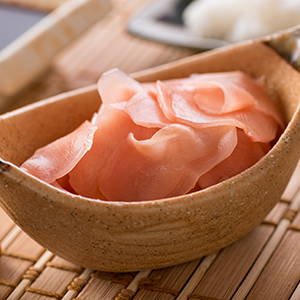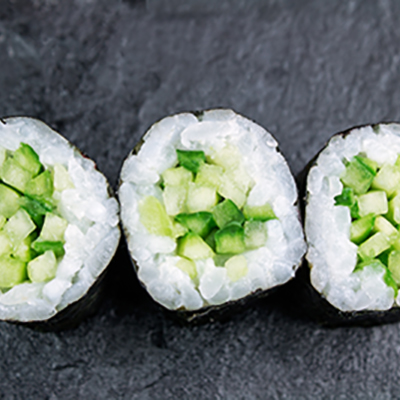Sushi Vocabulary

Get to know the sushi vocabulary!
- Abura: Walnut oil, colza seed oil and sesame oil are used for seasoning and not for cooking. The oil used for tempura is a vegetable oil aromatized with a few drops of sesame oil which provides a nutty taste to the fried ingredients.
- Chakin: Sweets made with pureed sweet potato.
- Flour: Rice flour and soybean flour are most frequently used and add a slightly nutty taste to Japanese dishes.
- Gari: Marinated ginger.
- Ginseng: Root used to flavour tea and wine.
- Gohan: Japanese rice. The term is used both for the rice and the meal. There is an old Japanese saying that says "tsukiyo no kome no meshi", "we never tire of eating even a simple bowl of rice by moonlight": o-kome (grains of rice); o-sake (rice wine); o-sembei (rice crackers)
- The prefix 'o' reflects the particular status, almost sacred in fact, of rice and its grains since ancient times.
- Round-grain Japonica becomes « sticky » once cooked. There are different varieties of glutinous rice, including Uruchimai and Mochigone used to make mochi.
- Rice based products: Crackers (o-sembei; Rice wine (o-sake); Mirin, a mild cooking wine
- Goma-dare: Sesame and daikon sauce usually served with shabu-shabu.
- Kamaboko: Fish paste sold in rolls or loaves. It should be sliced and added to noodles in soups and other simmered dishes. It can be served plain or in small portions as an accompaniment.
- Kanten: Agar is a transparent mucilaginous substance that is used like gelatine. Agar is made from certain types of red seaweed.
- Karinto: Fried sweet potatoes.
- Katsuo-bushi: Dried Bonito, from the mackerel family, is sold in pieces or in flakes. Bonito is used to flavour dashi, the staple broth of Japanese cuisine.


- Koh No Mono: Marinated vegetables usually served before dessert to add fibre and facilitate digestion.
- Konbu: Kelp is one of the main ingredients in dashi. Kelp is sun-dried, cut, folded and packed. Never wash or even soak it as this would remove all its flavour which is right on the surface. Simply moisten with a damp cloth. It can be fried or sauteed like a vegetable.
- Kyabetsu su zuke: Marinated cabbage usually served before dessert to add fibre and facilitate digestion.
- Maki: Prepared Japanese rice, wrapped in a sheet of seaweed (nori) then stuffed at the center with raw fish, caviar, omelette or vegetables. The raw fish must be extremely fresh, skinned, boneless and very thinly sliced. Bites of maki are served with a small bowl of sauce, a few slices of marinated ginger and a little wasabi paste.
- Matsutake: Pine mushroom.
- Mirin: Slightly sweet, amber coloured, rice wine with a very low alcohol content. It is a mild cooking wine that is used to flavour dishes. It is added to sauces used to coat meats for grilling.
- Miso: Traditional Japanese soup, it is a clear broth to which is added a small amount of ingredients which serve more as a decoration than a nutritional element. In Japan, soup is served as an appetizer.
- Mochi: Mochi is a sticky rice that is beaten while still very hot to obtain a paste that is moulded into different shapes. Its consistency is heavy and substantial. Use it wrapped in a sheet of seaweed or grilled and served with a sauce.
- Niban Dashi: Clear soup (broth) served in a teapot.
- Nori (seaweed sheets): Sun-dried seaweed, pressed into thin, slightly-toasted, brown or dark green sheets.
- Ocha: Green tea.
- Onigara-yaki: Cooked lobster.
- Otsukuri: Thinly sliced fish.
- Quail eggs: Used as a garnish in soups and appetizers.
- Sakana no gingamijaki: Greenland halibut or cod in parchment packets.
- Sake: Rice wine.
- Sansho and Shichimi (7 spices): Condiments. The Japanese do not use pepper and salt is replaced by soy. Depending on your preference, they can be purchased in mild, medium or spicy variety.
- Shabu Shabu: Much like what we refer to as fondue. All the ingredients are arranged on a large platter and then cooked at the table in warm broth. Each item is then dipped in very spicy sauce and then eaten. Once the meat and vegetables have been cooked and eaten, noodles are added to the broth and served in small bowls to each guest. No rice is served with this meal.
- Shirumono: This is the general term for soup – including the famous miso, the clear broth suimono and soup meals.
- Shokugo: Seasonal fruits.
- Shokuji: Steamed rice.
- Shoyu: Soy sauce; the staple Japanese seasoning. It is used to as a dip for sushi, tempura and grilled foods. It can be added to sauces, broths and soups. It is also used to baste or marinate meats before cooking or to season Japanese salads which are traditionally prepared with cooked marinated or pickled vegetables.
- Soy-based sauces: Teriyaki, used with grilled chicken or beef; Yakitori, used with chicken brochettes; Tempura
- Different types of soy sauces: Salt content: low-salt or regular; Aroma– mild to strong; Concentration – clear to dark (the darker the sauce, the thicker it is; Sugar content – depending on the brand
- Soba Noodles: Buckwheat flour noodles.
- Somen Noodles: Thread-like wheat flour noodles.
- Su: Clear, slightly-sweet rice vinegar used in vinaigrettes and to flavour certain dishes.
- Sukiyaki: Beef, mushrooms, tofu and wheat noodles stir fried in a wok.
- Sushi: This appetizer was first created in Tokyo in the early 1900. Along with the most popular nigiri-sushi, there are several other varieties including inari (stuffed with fried tofu), tiger eye (stuffed with calamari) and cooked sushi.
- Basically, it consists of a clump of vinegared rice, sometimes wrapped in dried seaweed (nori) and filled with a variety of ingredients. It can also be a cylinder-shaped clump of vinegared rice over which a trace of wasabi is applied and covered with a piece of raw fish.
- When the garnish is soft or semi-soft (fish roe or sea urchin), it will be added onto a clump of rice surrounded by a strip of nori forming a type of retaining 'wall' or vessel; this is called gunkan-maki (sushi-vessel).
- The different varieties:
- Maki-zushi or rolled sushi. The simplest are made by coating a sheet of nori with vinegared rice topped with small strips of fish, avocado, cucumber or other ingredient, tightly rolled up using a bamboo mat. The roll is then cut into bite-size pieces.
- Temaki, a hand-rolled version of maki-zushi. A sheet of nori is rolled into a cone shape and stuffed with vinegared rice topped with any choice of ingredients:
- Sake: with salmon; Maguro: with tuna; Ikura: with salmon caviar; Tako: with octopus; Saba: with mackerel; Ebi: with shrimp; Hotategai: with scallops; Kani: with crab; Mirugai: with clams
- Tamago: Egg rolls.
- Tamari: Thick, dark sauce with a stronger flavour than soy sauce.


- Tempura: A Japanese classic, this technique involves deep-frying lightly-battered vegetables, shellfish, fish, or chicken.
- Teppan – yaki: Foods cooked on a hot plate.
- Teriyaki: Broiled foods that have marinated in a sweet soy sauce.
- Udon Noodles: Wheat flour noodles that are either flat or round (thicker than soba noodles).
- Ume-Shu: Plum wine served with dessert.
- Umeboshi: Marinated plums usually served before dessert to add fibre and facilitate digestion.
- Wakame (seaweed): This seaweed is sold dry. It must be soaked in clear water for 20 minutes to re-hydrate for use in soups, cakes or as a decorative element.
- Wasabi: Japanese mustard or horseradish.
- In Japanese, wasabi translates to "mountain hollyhock"
- In stores, wasabi is sold in two forms: Powder: to which must be added a few drops of water and/or soy sauce to form a paste; Paste, sold in tubes
- Use as a condiment to accompany sushi and sashimi.
- Wok: Sauteed meat, fish or vegetables.
- Yakitori: Skewer-grilled foods.
- Yakitori Chicken: Traditional Japanese grilled chicken brochettes.
- Zenzai: Sweet soup made with red beans.
Simple And Easy Recipe Ideas!













